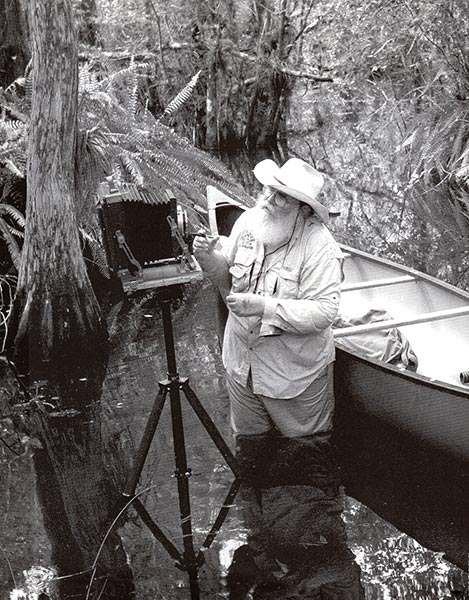 Clyde Butcher lifted his head and the straw hat with the yellowed brim tipped upward. A kind face, accented by lines that spoke of experience and wisdom, moved into the light. Wisps of gray hair curled in disarray like an unkempt garden. “I have lots of these,” he said pointing to his hat, “from new to intermediate to ragged. Originally, they were only to protect me from the sun. It sure can be hot in the Everglades.” Green eyes peered through large vintage glasses and a grin peeked through the cloud of silver mustache and beard. Along with the white hat, he wore a light green fishing shirt and khaki pants: the iconic look of this internationally famous photographer and environmentalist. His style is not pristine, but perfectly chaotic and he wore it well.
Clyde Butcher lifted his head and the straw hat with the yellowed brim tipped upward. A kind face, accented by lines that spoke of experience and wisdom, moved into the light. Wisps of gray hair curled in disarray like an unkempt garden. “I have lots of these,” he said pointing to his hat, “from new to intermediate to ragged. Originally, they were only to protect me from the sun. It sure can be hot in the Everglades.” Green eyes peered through large vintage glasses and a grin peeked through the cloud of silver mustache and beard. Along with the white hat, he wore a light green fishing shirt and khaki pants: the iconic look of this internationally famous photographer and environmentalist. His style is not pristine, but perfectly chaotic and he wore it well.
“I fell in love with photography when I was eight years old,” he said. “I had a Brownie Hawkeye camera and I began to take photos of anything I could shoot. My mother and father were both artistic and encouraged my interest in photography. When I was nine, I upgraded my camera to a Yashica Twin Lens. I knew then that I wanted bigger and better equipment.”
As Clyde’s father followed his employment path to Ohio and then California, Clyde was exposed to various landscapes. He was not enthralled with the rows of box-like houses, stagnant buildings and rusting alloy of school buses and cars. “My parents took the time to take me to five national parks on the west-coast of America over a summer,” he said. “The Grand Canyon and the Redwood National Parks opened my young mind to the immensity of the world. It is there that I first found beauty in nature. It changed my life. I began to realize that movement and light had tremendous effects on a landscape, an object and ultimately on a photograph.”
“I never thought, however, that I would make photography my career. After graduating high school in Beaumont, California, my mother encouraged me to attend college. I followed her advice and it’s good that I did. Although I was scraping by financially, living out of my car at the time, I met my wife, Niki, on a ‘blind-date’ while attending California Polytechnic State University. Niki is an artist in her own right. Fifty-six years later, we continue to be a great team. She is always standing next to me on all of my shoots. I understand the science behind my photographs and balance that against their beauty. However, Niki is strictly emotional. With a bit of her input, we create photos that appeal to both men and women.”
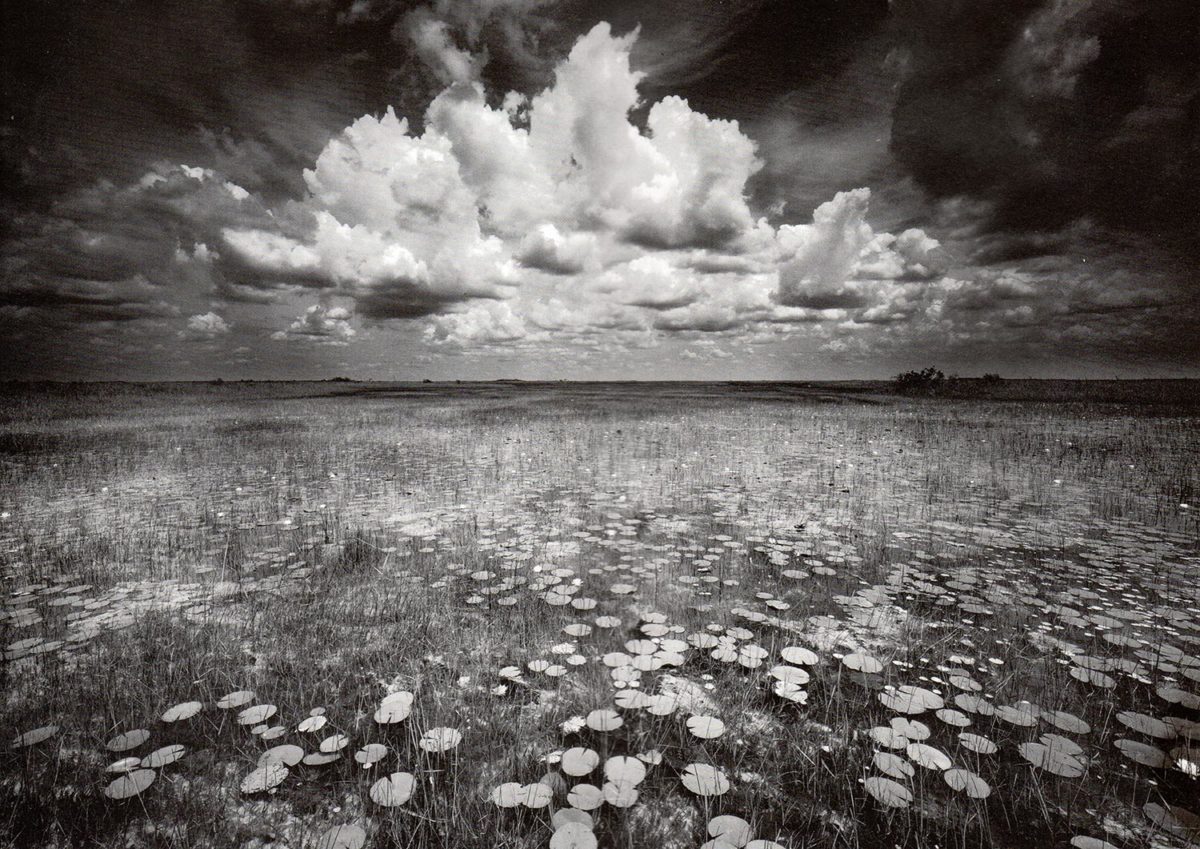
The experiences of Clyde’s early years and his exposure to photography and environmental issues along with a sprinkling of political awareness carved the road to Clyde’s destiny. He saw the dangers that maltreatment of people, property and planet Earth created. At one point, he and Niki lived aboard a boat he had built. Without electricity and modern accoutrements Clyde focused on the colors of the local landscape as photography became the voice that Clyde would use to communicate what was personally important: love of family, emotion and the environment. “Most people photograph objects, I’m trying to photograph feelings,” he said. “I only photograph something if it feels good to me. Then I make my pictures so large that you can’t see them, not without scanning the entire image with your eyes to see the detail. If I can pull people into the print and make them feel comfortable, as if they are in the landscape, then I am happy.” It was standard practice for Clyde to move slowly through chest-deep waters of a swamp as his canoe held the large format view camera until his internal lens focused upon a pristine scene. That shot would often be created into mural-sized photos with increased detail and then printed onto fiber-base silver gelatin paper using photography trays that he built by hand.
Clyde’s iconoclastic photographs hang prestigiously in museums, hotels and offices throughout the world. The Fort Lauderdale Museum of Art along with the district headquarters of Tropicana in Bradenton, the Naples’ Ritz Carlton, the Naples Beach Hotel, the Federal Interior Department in Washington, D.C., Senators Lindsay Graham’s and Marco Rubio’s offices, the National Gallery in Prague, Czech Republic and various U.S. Embassies are among many others around the world who have chosen Clyde’s photos to represent Florida and our local living ecosystem, the Florida Everglades. They serve to beautifully testify to the importance of environmental conservation, a cause to which Clyde has received many recognitions and awards. “The Everglades is a living organism that we must care for. It’s our responsibility Its health is a reflection of our global well-being,” he said.
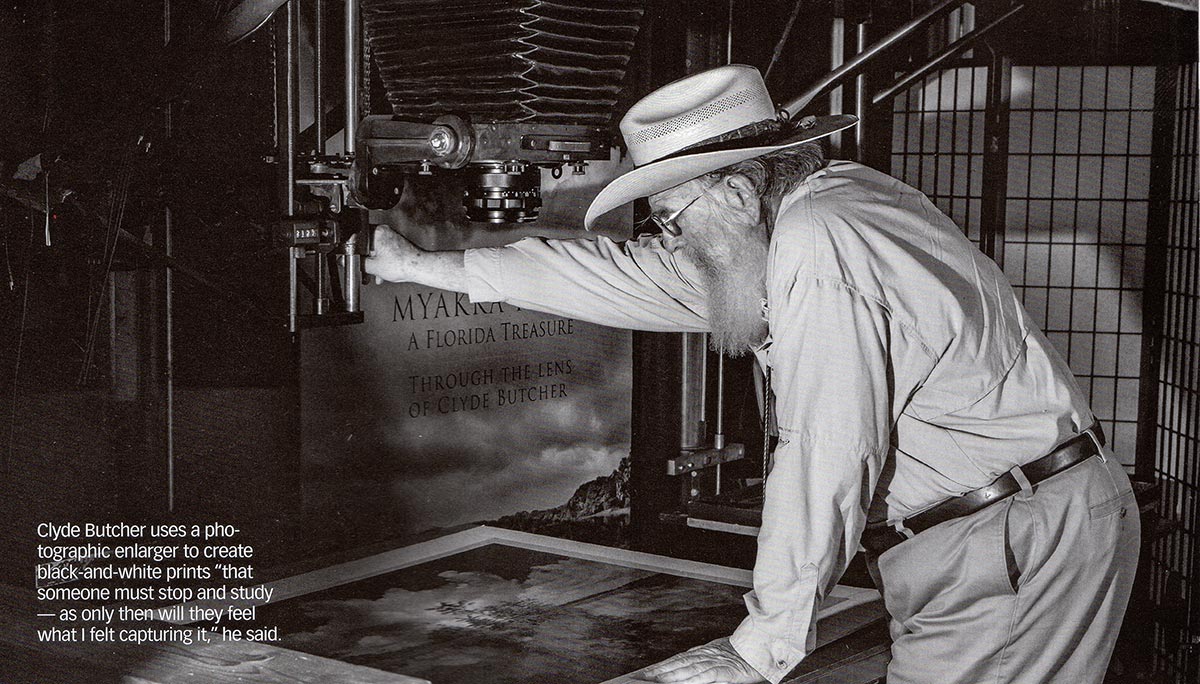
Clyde has photographed beauty in many places, from California to Oregon, Wyoming, Ohio, Hawaii, Cuba, Czech Republic, Spain and Florida. His soul has always been drawn to boats and to natural waters. “Niki thinks I was a mariner in another life,” he said with a grin. “I feel relaxed and peaceful standing without waders in the clear swamp water. We have to do everything we can to save our planet. Earth is the most beautiful place in our Universe and the Everglades is our heaven,” he said.
Clyde altered his photographic style in 1986 following the tragic death of his seventeen year old son. “When Ted was killed by a drunk-driver I looked for solace in nature. I went from taking color photos, which were financially successful, to huge black and white pictures in the Florida Everglades. It was and still is a form of personal therapy. A spiritual experience. Without that energy my photos would feel empty. In them, light becomes the subject matter and contrast, between good blacks, great whites and all the shades of gray, combine to create a print that someone must stop to study as only then will they feel what I felt capturing it.”
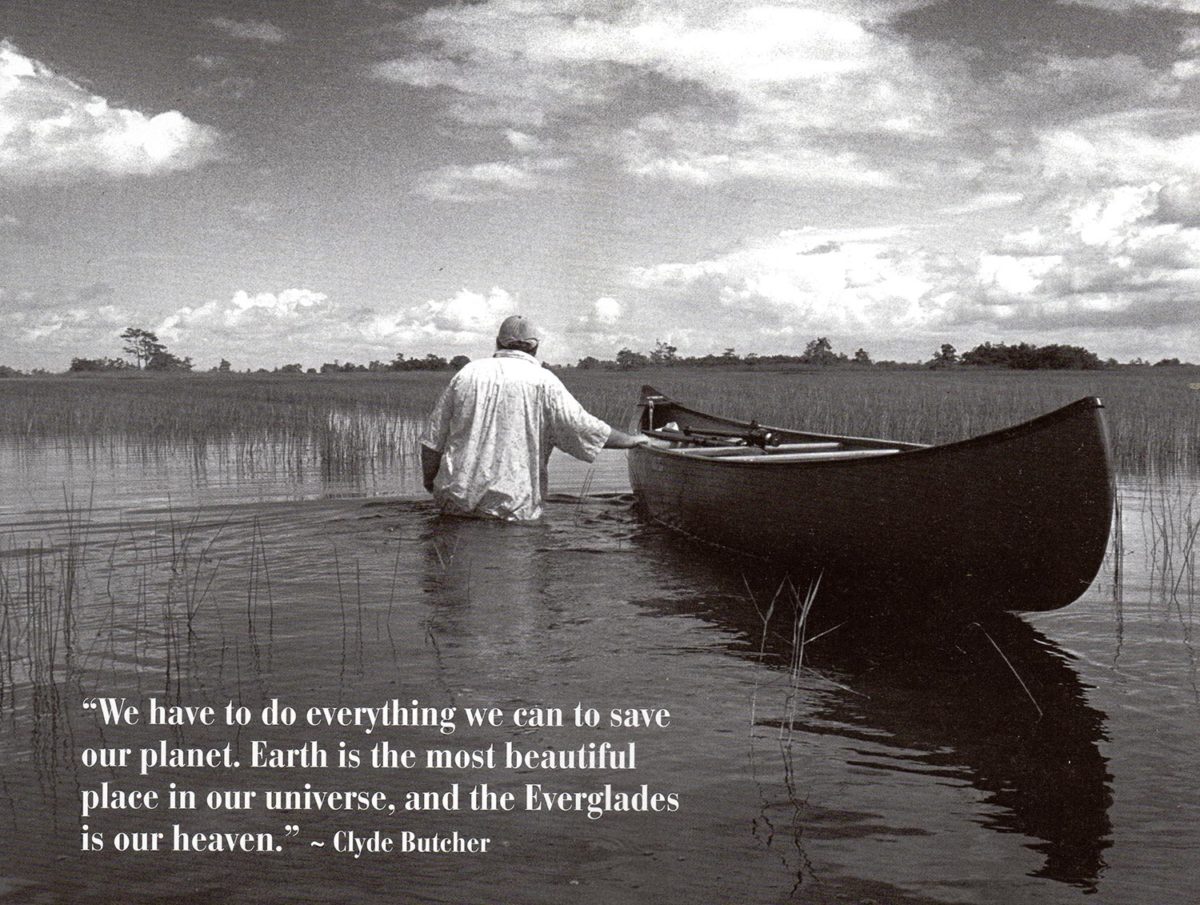
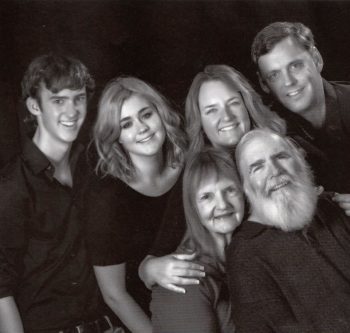 “I love the visual chaos that is nature and the swamp. When I take a photo I search until I find relaxation in a setting. I take that chaos and I make order out of it,” he said. “That is what I do. Even though I graduated from college as an architect, I’m not fond of buildings. They’re bad for the environment taking up too much land and energy. I’d rather be surrounded in natural clutter, not in the straight lines of trees that were planted deliberately.” It’s the process of locating beauty in the accidental chaos that is magical for Clyde. He and Niki choose to live in a modular home with solar panels and an electric car in a mobile-home park. They are situated on a bay where their backyard is filled with shades of blue from the water, ribbons of gold from each sunset and rich greens from the mangroves. They surround themselves in the love and talents of family as daughter, Jackie, son-in-law, Neal Obendorf and grand-daughter, Kayla, work with Clyde and Niki at their galleries. Clyde hopes that grandson, Robert, will join them also.
“I love the visual chaos that is nature and the swamp. When I take a photo I search until I find relaxation in a setting. I take that chaos and I make order out of it,” he said. “That is what I do. Even though I graduated from college as an architect, I’m not fond of buildings. They’re bad for the environment taking up too much land and energy. I’d rather be surrounded in natural clutter, not in the straight lines of trees that were planted deliberately.” It’s the process of locating beauty in the accidental chaos that is magical for Clyde. He and Niki choose to live in a modular home with solar panels and an electric car in a mobile-home park. They are situated on a bay where their backyard is filled with shades of blue from the water, ribbons of gold from each sunset and rich greens from the mangroves. They surround themselves in the love and talents of family as daughter, Jackie, son-in-law, Neal Obendorf and grand-daughter, Kayla, work with Clyde and Niki at their galleries. Clyde hopes that grandson, Robert, will join them also.
One would think that Clyde would still walk the swamp in search perhaps of the elusive ghost orchid. But one would be wrong. Clyde Butcher continues to search for contentment in the one shot, where the air hangs still and the light glows perfection, so he can capture the beauty of the living swamp and share his Florida Everglades with the world.
